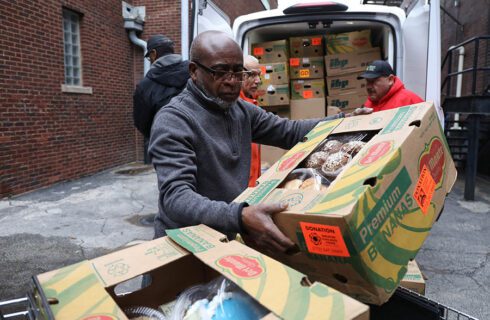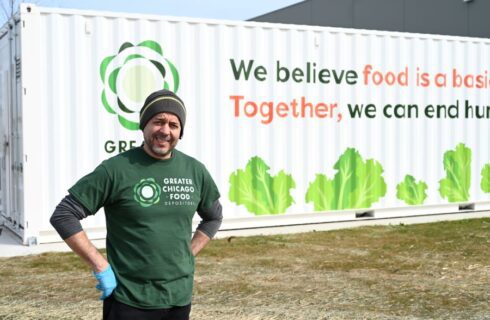Chef Michael Goss and Bianca Murphy have spent their careers serving people through food.
Today, they are at the forefront of the Food Depository’s newest venture: prepared meals.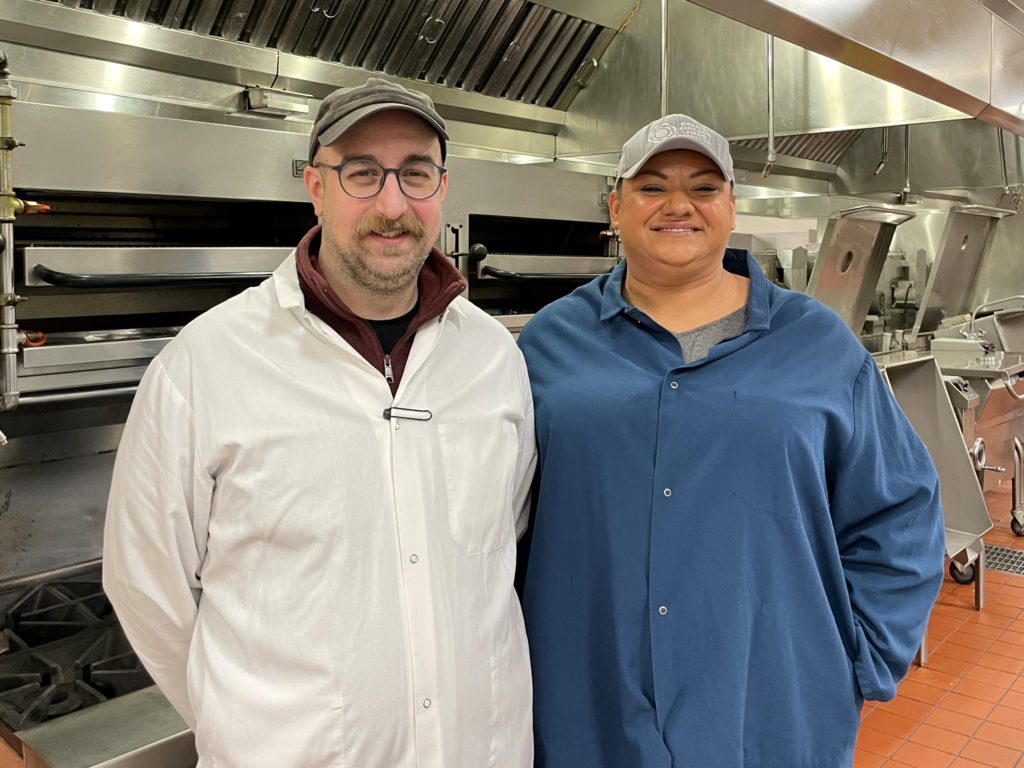
Executive chef Michael Goss (left) and Bianca Murphy, Registered Dietician Nutritionist. Both help lead the effort for the Food Depository's meal production.
What kinds of meals are your team producing?
Chef Michael Goss: We have a really diverse menu that is all based on nutrition. These are fully composed meals. For example, we offer a whole wheat seasonal pasta bake with ricotta melt. We do vegetarian lasagna. We do a variety of lunch items like soups and stews; everything from a Moroccan carrot and lentil soup, to a creamy broccoli, to a Tuscan tomato with whole grain bread. We do market salads for our older adults and very recognizable deli items like chicken salad or tuna salad, which we pair with whole grains and house-made vinaigrettes. It’s all heart-healthy, consciously prepared foods that really cover the whole spectrum of meal types. Largely we’re working with lean proteins, low or no saturated fat, controlled added sugar, and whole grains. So we’re basing it off the healthful building blocks of a composed meal.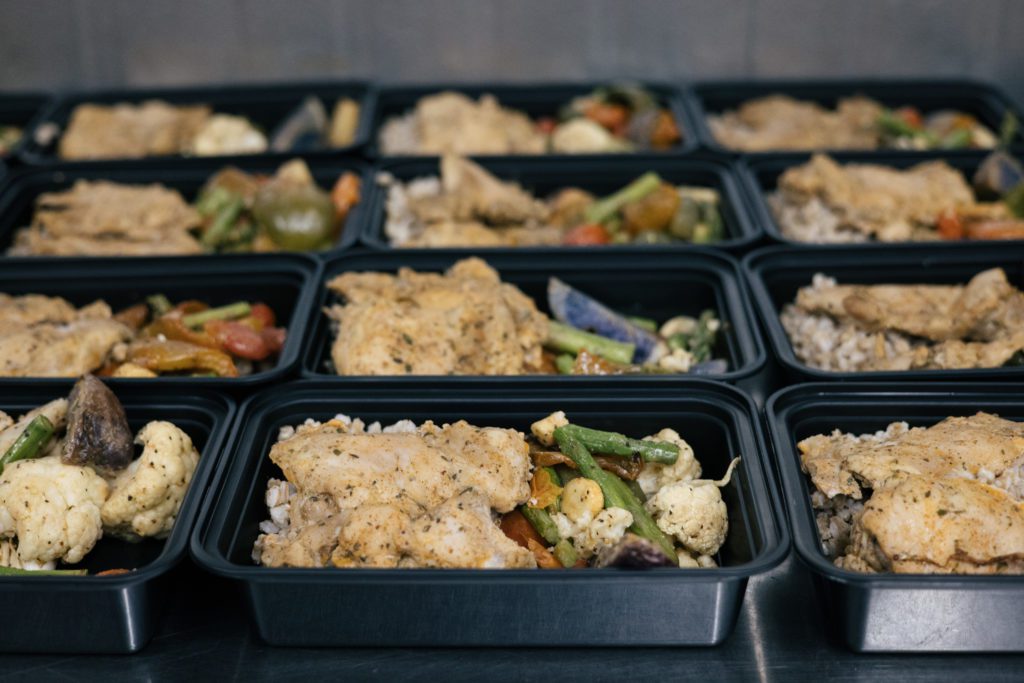
The Food Depository currently creates prepared meals for three audiences: community members in need of medically tailored meals, older adults, and food pantry partners. (Photo by Alyssa Schukar for the Food Depository)
How do we expect these offerings to expand once the Food Depository’s new prepared meals facility is complete?
The biggest piece of puzzle is just being able to make more of it. That’s number one, expanding our production capacity and capability to take those healthful options and offer them to more food access partners going through our normal channels of distribution. We do fully expect older adult programs to continue, we expect medically tailored meals to grow to take on more clients and accommodate additional comorbidities. But the biggest piece is taking the menu we now know works, and is delicious, and make it widely accessible throughout our network.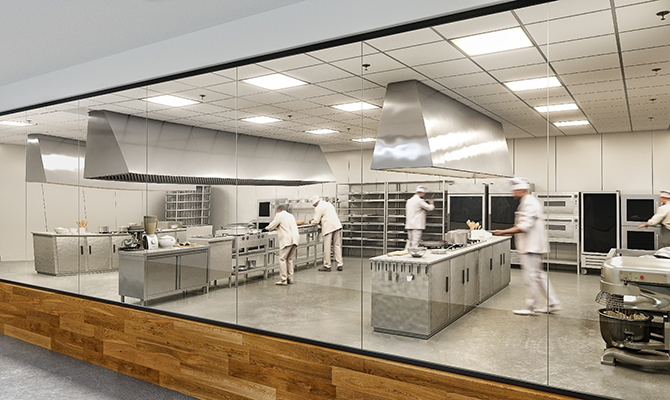
The Food Depository's upcoming stage of the Nourish Project includes the creation of a new 36,700 square-foot facility that will house a meal production kitchen.
What is a medically tailored meal, and what do you consider when creating one?
Bianca Murphy: Medically tailored meals are meals that are approved by Registered Dietician Nutritionists (RDN) that reflect appropriate dietary therapy. Diet and meals are recommended to a patient by an RDN based on a nutritional assessment and a referral by a healthcare provider to address medical diagnoses, symptoms, allergies, medication management and a condition’s side effects to ensure the best possible nutrition-related health outcomes. The Food Depository’s medically tailored meals currently address hypertension, which is high blood pressure; renal diseases 1 and 2 without dialysis; diabetes that is not insulin dependent and hyperlipidemia, which is high cholesterol. Our meals accommodate all these conditions at once. I go through all the requirements for those diets based on their different regulatory guidelines and pull them together. That’s key – being able to serve as many people, as many patients, as quickly as possible with the same care. It's amazing what food can do without having to use pharmaceuticals.For those with these chronic health conditions, what kind of impact can these types of meals have on their wellbeing?
BM: There’s a high correlation between people with food and nutrition insecurity suffering from these diseases. The problem with that is that it is a familial issue. So if mom and dad eat like that, so do kids. Diseases we used to see in our grandparents we’re seeing in our children. It’s a household issue, it’s a community issue – that’s how impactful food is. Some great feedback we’ve received from patients that actually made us cry was that it was indescribable to them to open the fridge and know there was food there, but to also know the food they were eating was good for them and that they could easily duplicate that for their children. A little bit of knowledge goes really far. It impacts the children who hopefully grow up to eliminate a disease that doesn’t have to be a life sentence. CMG: It can’t be stressed enough how important it is to take the guesswork away for them, so that they don’t have to worry and wonder. If they know the food they’re being delivered is going to help control that issue, that’s what it’s meant to do.A medically tailored meal isn’t a cure, but it’s something helping control those comorbidities and not exacerbate them.BM: It’s also kind of like a stopgap from ending up with further comorbidities that usually steamroll each other, but don’t have to.
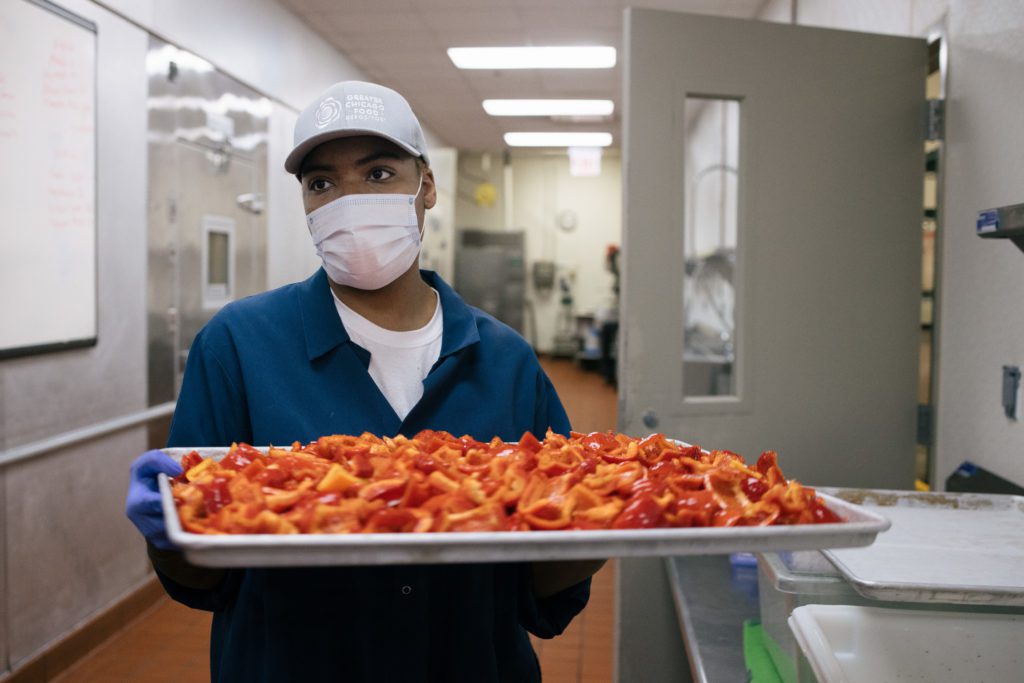
Meal Production Assistant Diane Hawthorne prepares fresh peppers in the Food Depository's kitchen. (Photo by Alyssa Schukar for the Food Depository)
What are your priorities and processes when crafting recipes for these prepared meals?
CMG: The first is the research and development piece of it. The chefs and dietician team members all have a seat at the table. We don’t prepare meals and think about the nutrition after – it’s all part of the same process. It is a fairly lengthy process, in which we evaluate the menus, go through the actual cooking and testing process of formulating that recipe. There’s a standardization process to ensure we’re able to properly scale the meals. Then there’s a full dietetic evaluation and analysis. There’s about 60 days worth of work on a meal before it ever hits the menu. BM: We started looking at recipes that would work across the board for medically tailored meals and older adults and found that they also work well for partners. We’ll maybe just give those non-medical groups a little bit more, or make adjustments like that, because medically tailored meals are strict on quantity. Everything’s made by us, so the control is key. CMG: We also realized early on is if we’re thinking of food as medicine, you have to take your medicine in order for it to be effective. If you’re not eating it, you’re not taking your medicine. We had to consider how can we use our time wisely to develop components that nobody would necessarily know or differentiate as healthful? In how we prepare things, in the types of herbs and spices that we use, focusing on bold flavors that are sensitive to the communities that we serve, we had to be very thoughtful about all of that. If we only prioritize the nutrition, you can easily go out and buy bagged, pureed dietary supplements that taste just like a bagged, puree dietary supplement. We didn’t want to go in that direction.We wanted to produce food that looks great, tastes great and also happens to be beneficial.
How do you factor in the preferences of the culturally diverse audiences that we serve across Cook County? Why is this important?
CMG: As a kitchen in general, one of the worst things you can do around cultural sensitivity is make assumptions about if a certain community or diaspora eats a certain way. Those assumptions can lead to something that is incredibly inaccurate. We’re not really talking about authenticity; we’re talking about the needs and wants of the community. Part of that has been making sure we have a dialogue with our partners and we’re listening to the feedback of their clients. BM: We have to look at not just flavor, but also styles of cooking, because traditionally how something is cooked as well makes a difference to those individuals. So we embrace that and go from there so that we don’t have a very flat ‘American’ menu and there’s different styles. It’s wholly been appreciated. We’ve had comments from clients like, ‘it’s beautiful, it’s flavorful,’ or ‘it’s opened up my exploration of different foods.’ That’s something people don’t always realize. Embracing the cultures around you is embracing their different flavors. Learn more about the Food Depository’s Nourish Project and prepared meal expansion.Share This Post


